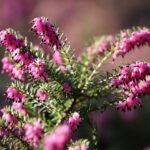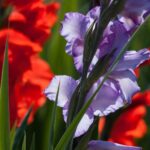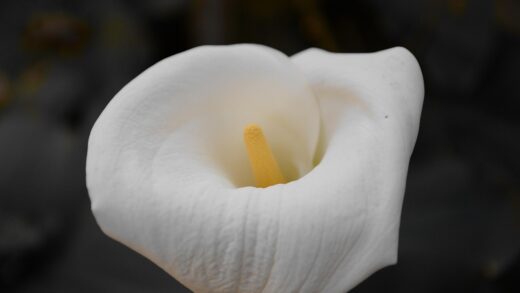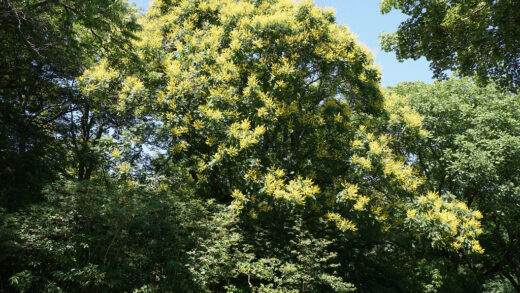Successfully establishing Algerian ivy begins with proper planting, a foundational step that sets the stage for vigorous growth and long-term health. Whether you intend to use it as a lush ground cover to blanket a shady area of your garden or as a trailing houseplant to cascade from a hanging basket, the initial planting process is critical. Selecting an appropriate location with the right soil and light conditions is paramount, as this will provide the strong start the plant needs to thrive. Proper preparation of the planting site ensures that the roots can easily establish themselves and access the necessary water and nutrients from the outset.
The process of planting Algerian ivy is straightforward, making it accessible even for those new to gardening. The key is to handle the plant with care to minimize stress on its root system and to provide it with a welcoming environment. This involves ensuring the soil is loose and well-draining and that the plant is placed at the correct depth. Once planted, consistent aftercare, especially during the first few weeks, is vital for helping the plant acclimate to its new surroundings and begin its journey of robust growth.
Propagation offers a rewarding and cost-effective way to create new Algerian ivy plants from an existing one. This resilient vine is exceptionally easy to propagate, most commonly through stem cuttings, a method that yields new, independent plants in a relatively short period. This allows you to easily expand your collection, fill in bare spots in your garden, or share plants with friends and family. Understanding the simple techniques of propagation unlocks the potential for an endless supply of this beautiful foliage plant.
By mastering both planting and propagation, you gain full control over the lifecycle of your Algerian ivy. You can cultivate a single plant into a thriving green feature or develop multiple specimens to enhance various parts of your home and garden. This article will guide you through the essential steps for both planting a new Algerian ivy and propagating it successfully. Following these professional techniques will ensure your plants not only survive but flourish, rewarding you with their timeless beauty.
Selecting the right location
The first and most crucial decision in planting Algerian ivy is choosing the right location, as this will heavily influence its future growth and health. For outdoor planting, select a spot that offers partial shade, especially protection from the harsh afternoon sun. The dappled light found under a tree canopy or the gentle morning sun on the east side of a structure provides the ideal balance of light and shade. Too much direct sun can scorch the leaves, while deep, constant shade can lead to sparse, leggy growth and diminish the vibrancy of variegated cultivars.
More articles on this topic
Indoors, the same principle of bright, indirect light applies. Place your Algerian ivy near a window where it can receive plenty of filtered sunlight without being exposed to direct solar rays. An east-facing window is often perfect, providing gentle morning light. If you only have south or west-facing windows, which receive more intense sun, position the plant a few feet back from the glass or use a sheer curtain to diffuse the light and prevent leaf burn.
Consider the plant’s vigorous growth habit when choosing its location. Outdoors, Algerian ivy can spread rapidly and may become invasive if not managed. Avoid planting it near delicate, slow-growing plants that it could easily overwhelm. It is an excellent choice for covering bare ground where other plants struggle to grow, or for climbing up sturdy walls and trellises, but be mindful of its potential to attach to and damage surfaces like wood siding or brick mortar over time.
Finally, assess the soil conditions of your chosen spot. Algerian ivy thrives in well-draining soil that is rich in organic matter. Before planting, it is wise to amend heavy clay or sandy soils with compost or other organic material to improve both its texture and nutrient content. Ensuring good drainage from the start is essential to prevent water from pooling around the roots, which is a primary cause of root rot and other fungal diseases.
The planting process step-by-step
Once you have selected the perfect location, you can begin the planting process. If you are planting outdoors, start by preparing the soil. Clear the area of any weeds or debris and loosen the soil to a depth of about 12 inches using a garden fork or tiller. Incorporating a few inches of compost or other well-rotted organic matter will enrich the soil, improve its drainage, and provide a nutrient-rich foundation for the new plant to establish itself.
More articles on this topic
When you are ready to plant, carefully remove the Algerian ivy from its nursery pot. Gently squeeze the sides of the container to loosen the soil and then tip the plant out, supporting the base of the stems with your hand. If the roots are tightly wound in a dense ball, a condition known as being root-bound, gently tease them apart with your fingers to encourage them to grow outwards into the new soil. This step is crucial for helping the plant establish a strong and expansive root system.
Dig a hole that is approximately twice as wide as the root ball and just as deep. Place the plant in the center of the hole, ensuring that the top of the root ball is level with the surrounding ground. Planting it too deep can lead to stem rot, while planting it too high can expose the roots and cause them to dry out. Backfill the hole with the prepared soil, gently firming it down around the root ball to eliminate any large air pockets.
After the plant is securely in place, the final step is to water it thoroughly. Give the newly planted ivy a deep and generous watering to help settle the soil around the roots and provide essential moisture. This initial watering is critical for reducing transplant shock and helping the plant acclimate to its new environment. For the first few weeks, keep a close eye on the soil moisture, watering regularly to ensure it remains consistently moist but not waterlogged as the plant establishes itself.
Propagating from stem cuttings
Propagating Algerian ivy from stem cuttings is a simple and highly effective method for creating new plants. The best time to take cuttings is during the spring or early summer when the plant is in its active growth phase. Look for healthy, vigorous stems on the parent plant. Using a clean, sharp pair of scissors or pruning shears, take a cutting that is about four to six inches long, making the cut just below a leaf node, which is the small bump on the stem where a leaf emerges.
Once you have your cutting, prepare it for rooting by removing the leaves from the bottom half of the stem. This is important because any leaves left below the soil or water level will rot, potentially contaminating the cutting and hindering root development. You should be left with a bare stem at the bottom and a few leaves at the top. The top leaves will continue to photosynthesize and provide energy for the cutting as it develops new roots.
You now have two primary options for rooting your cutting: in water or directly in soil. For water rooting, simply place the bare end of the stem in a glass or jar of water, ensuring that the remaining leaves are above the waterline. Place the jar in a location that receives bright, indirect light and change the water every few days to keep it fresh. Within a few weeks, you should see small white roots beginning to form from the submerged nodes.
For soil rooting, you can dip the cut end of the stem in a rooting hormone powder to encourage faster and more robust root growth, although this step is often not necessary for an easy-to-root plant like ivy. Plant the cutting in a small pot filled with a moist, well-draining potting mix, burying the bare stem deep enough so that at least one or two nodes are covered. Place the pot in bright, indirect light and keep the soil consistently moist until the cutting has established a strong root system.
Care for new plants and cuttings
Proper care immediately following planting or propagation is crucial for ensuring the long-term success of your new Algerian ivy plants. For newly planted ivy, whether in the garden or in a pot, maintaining consistent soil moisture is the most important task. The soil should be kept evenly moist to help the roots establish, but avoid overwatering as this can lead to rot. Check the soil every few days and water deeply whenever the top inch begins to feel dry.
Young plants and new cuttings are more sensitive to environmental stress than established plants. Protect them from extreme temperatures and direct sunlight, which can cause wilting and scorching. If you have rooted cuttings in water, it is time to transplant them to soil once the new roots are about one to two inches long. Plant them in a small pot with a well-draining mix and water them thoroughly, treating them as you would any young plant.
Avoid fertilizing your new Algerian ivy for the first month or two after planting or potting. The plant needs to focus its energy on developing a strong root system, and the fresh potting soil will contain enough nutrients to support it during this initial phase. Introducing fertilizer too early can burn the delicate new roots. Once you see signs of active new growth, you can begin a regular feeding schedule using a balanced, half-strength liquid fertilizer.
Patience is key when waiting for new cuttings to take root and for newly planted ivy to establish itself. It may take several weeks before you see significant new growth. You can check if a soil-propagated cutting has rooted by giving it a very gentle tug; if you feel resistance, it means a root system has begun to form. Once established, your new Algerian ivy will begin to grow more vigorously, rewarding your efforts with its beautiful foliage.
Common challenges in establishment
One of the most common challenges when establishing a new Algerian ivy plant is transplant shock. This stress response can cause the plant to wilt, droop, or even drop a few leaves immediately after being planted or repotted. To minimize transplant shock, handle the root ball as gently as possible during the planting process and ensure the plant is well-watered immediately afterward. Providing optimal growing conditions, especially avoiding direct sunlight and extreme temperatures, will help the plant recover more quickly.
Another significant issue is improper watering, which can manifest as either overwatering or underwatering. Overwatering is particularly dangerous as it can lead to root rot, a fungal disease that can quickly kill the plant. The signs include yellowing leaves, a mushy stem base, and wilting despite moist soil. Conversely, underwatering will cause the leaves to become dry, crispy, and brown at the edges. Establishing a consistent watering routine based on checking the soil’s moisture level is the best way to avoid these problems.
For those propagating cuttings, a common pitfall is the failure of the cuttings to root. This can be caused by a variety of factors, including using an unhealthy parent stem, not keeping the rooting medium consistently moist, or placing the cutting in an environment with insufficient light or humidity. Using a rooting hormone can increase the success rate, as can creating a more humid environment by covering the pot with a clear plastic bag to trap moisture until roots have formed.
Finally, newly established plants can be more vulnerable to pests and diseases. Keep a close eye on your young ivy for common pests like spider mites or aphids, especially if it is grown indoors. Check the undersides of leaves regularly and treat any infestations promptly with insecticidal soap or neem oil. Ensuring good air circulation around the plant and avoiding overly wet conditions can also help prevent the development of fungal diseases like powdery mildew or leaf spot.


















